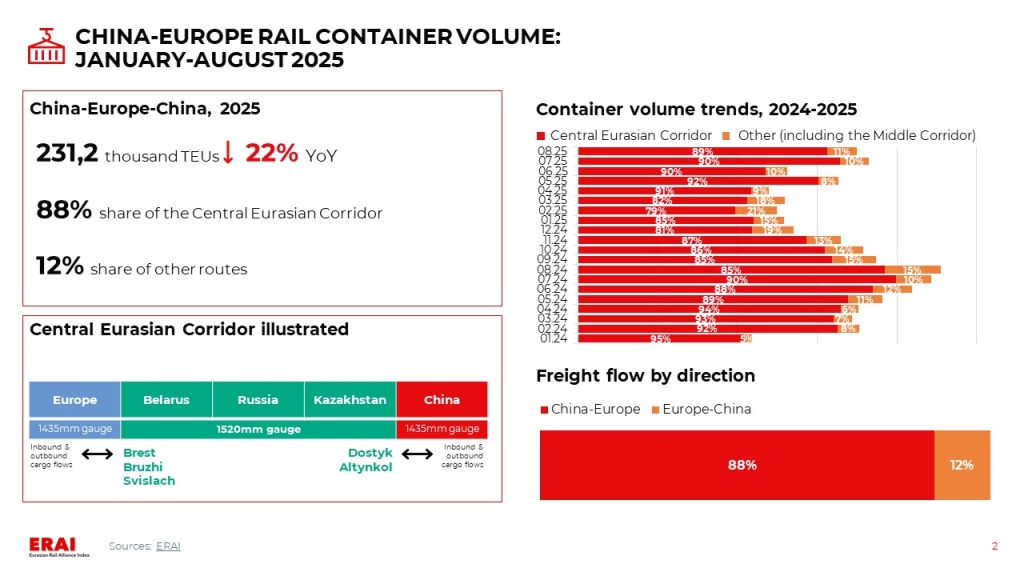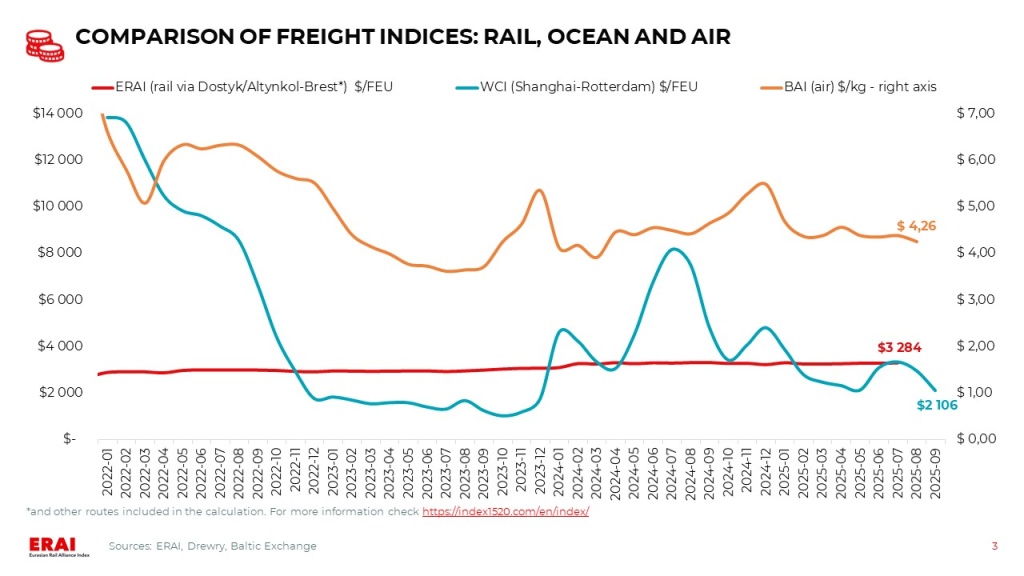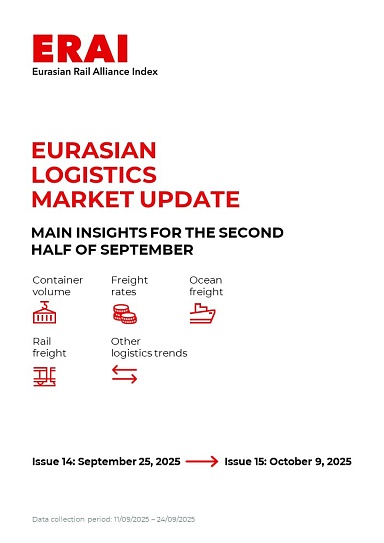When using, citing, or distributing the materials from this report, it is mandatory to reference the ERAI portal and include the webpage address https://index1520.com as the source of information.
China-Europe logistics market
Demand outlook
- China’s economic growth slowed in August. Retail sales increased by 3,4% YoY, while industrial production grew by 5,2%, with both indicators falling below expectations [CNBC]. Weak domestic demand continues to constrain imports, exacerbating the trade imbalance with Europe. Deflation remains an additional pressure factor: in August, the CPI decreased by 0,4% YoY, and the PPI has remained negative for the third consecutive year. China’s current industrial and export growth is driven by high-tech sectors. For instance, in January-August, exports of electrical and machinery products rose by 9,2% accounting for 60.2% of the total volume [CGTN].
- Weakening industrial dynamics in the Eurozone in September, as indicated by a drop in the manufacturing PMI to 49.5 and a slowdown in output growth [S&P Global], are fostering cautious expectations regarding trade flows. A significant pressure factor remains the demand for export orders, which has been declining for 31 consecutive months. A similar trend is observed in manufacturing procurement activity, which has been contracting for the 39th consecutive month. Moreover, in September, the rate of decline for these indicators accelerated to its fastest pace in six months.
- In January-August, the volume of China—Europe—China rail container transportation decreased by 22% YoY. In August, the total shipment volume across all competitive routes fell by 23% YoY and by 4% MoM.
- Demand for sea freight on the Asia—Europe route remains weak. European importers are maintaining a cautious approach to procurement amid high inflation and excessive warehouse inventories [Flexport]. No significant changes are expected until after China’s Golden Week (October 1–8).

Freight rate trends
- The Shanghai-Rotterdam WCI fell by 11% last week to $1 910/FEU (-36% MoM, −59% YoY) [Drewry]. Freight rates have returned to the lows last observed in late 2023. According to GeekYum, for the end of September — first half of October, most carriers are quoting rates in the range of $1 400-1 700/FEU.
UPDATE: As of the evening of September 25, 2025, the latest WCI Shanghai-Rotterdam reading has declined by 9% WoW — down to $1 735/FEU.
- Futures quotes indicate a further decline in freight rates in the near term, but with potential for growth by year-end. The forward curve suggests a decrease in Asia-Europe rates from current levels to around $1 400/FEU by the end of October, followed by a rise to approximately $2 100/FEU by the end of the year.

Other trends
- Chinese carrier Sea Legend Shipping* has launched the first regular container line to Europe via the Northern Sea Route [SCMP]. The route includes the ports of Qingdao, Shanghai, Ningbo, Felixstowe, Rotterdam, Hamburg, and Gdańsk. The transit time from Ningbo to the UK (Felixstowe) offers a transit time of 18 days (for comparison: transit time via the Ningbo—Wilhelmshaven line through the Suez Canal, launched earlier this year, is 26 days). The vessel will arrive at the final destination, Gdańsk, on October 16. The Istanbul Bridge vessel with a capacity of 4 890 TEU is deployed on the route. The maiden voyage was fully booked.
Ocean freight: intensifying downward trend
- Current Situation and Near-Term Outlook: Rates Continue to Decline Amid Falling Demand and Persistent Market Imbalance.
- Demand for Asia—Europe sea freight remains weak. European importers are maintaining a cautious procurement approach due to high inflation and excessive warehouse inventories [Flexport]. No significant changes are expected until after China’s Golden Week (October 1–8).
- Despite an increase in blank sailings in late September — early October, the scale of cancellations is lower than in previous years, and overall capacity remains excessive. According to DHL Global Forwarding’s expectations, the current market balance will persist until December. Carriers will likely attempt to reduce capacity again, but given ongoing competition, these measures are highly probable to prove ineffective, as before.
- The Shanghai—Rotterdam WCI fell by 11% last week to $1 910/FEU (-36% YoY, −59% MoM) [Drewry]. Freight rates have returned to the lows last seen in late 2023. According to GeekYum, for the period from late September to the first half of October, most carriers are quoting rates in the range of $1 400-1 700/FEU.
UPDATE: As of the evening of September 25, 2025, the latest WCI Shanghai-Rotterdam reading has declined by 9% WoW — down to $1 735/FEU.
- Port delays continue. In Asia, the cause is increased demand for shipments on intra-regional routes, as well as to South America and Africa. In Europe, structural constraints persist, primarily related to hinterland evacuation capabilities [DHL Global Forwarding]. As of 20/09/2025, delays amounted to 1.6 million TEU in North Asia (21% MoM) and 221 thousand TEU in Northern Europe (28% MoM) [Linerlytica].
- Medium- and long-term outlook: The overall trend continues to point towards a growing supply-demand imbalance and intensifying competition.
China-EAEU logistics market
Import and export trends
- On September 12, the Board of Directors of the Bank of Russia decided to reduce the key rate by 100 basis points, to 17.00% per annum. Despite this reduction, the Bank of Russia intends to maintain the tight monetary conditions necessary to return inflation to the 4% target by 2026. The decision is based on the fact that, although the economy is returning to balanced growth, inflation expectations remain high, and current price growth consistently exceeds the target.
- In August, Russia increased imports of passenger cars from China to their highest level since the beginning of the year, once again becoming their main importer [RIA News]. Chinese supplies to the Russian market increased by a quarter at the end of summer; however, year-on-year, they halved, amounting to $796.4 million. In total, China exported $10.2 billion worth of automobiles to other countries in August, which is 20% more than sales in August last year. Exports over the eight months amounted to $69.4 billion compared to $59.2 billion in January-August 2024.
- After a prolonged decline, container imports into Russia have shown volume growth since July. However, the market remains in crisis due to collapsing rates and profitability, forcing operators to artificially limit transportation. Forecasts for 2025 are cautious, and a significant recovery in rates is not expected until mid-2026 [InfraNews].
- In the first eight months of 2025, export rail transportation across the Russian-Kazakh border increased by 3,8%, reaching 20 million tons. Container transportation volume saw the strongest growth, up 46% to 254.4 thousand TEU. The main driver is shipments to China via Kazakhstan: freight turnover grew by 52% (to 2.9 million tons), and container shipments increased by 49%. The main growth came from supplies of fertilizers, grain, chemical products, and paper [RZD Partner].
- In the near term, specifically until the end of 2025 and early 2026, the logistics market is unlikely to show significant growth. Despite some recovery in imports since July, a full seasonal peak in August-September did not materialize, and the trend remains weaker than in previous years. High inflation expectations and tight monetary policy in Russia will continue to constrain consumer demand and, consequently, imports, limiting the growth of cargo flows. At the same time, export transportation shows significant growth and remains a key driver supporting container turnover amid moderate import volumes. According to CRCT portal data, the main increase in shipments to China is attributed to the Altynkol border crossing, which saw a 146% YoY growth over eight months. Clearer growth prospects will emerge in the second half of 2026 as the macroeconomic situation stabilizes. The forecast will continue to be influenced by the trajectory of the key rate, its impact on inflation and consumer activity, as well as the resolution of cross-border settlement issues between Russia and China.
- Import rates in the China-Moscow corridor have remained almost unchanged over the past 2 weeks for both direct and multimodal transportation. The average cost of transportation via Far Eastern ports is ~$4,000/FEU(SOC). Rates for direct rail transportation are at the level of ~$4,600/FEU (COC).
- From September 21 to 30, 2025, KTZ has temporarily suspended the dispatch and acceptance of foreign loaded and empty wagons. This measure applies to most types of foreign-registered wagons, with exceptions for tankers carrying food products, gas, and chemicals, as well as wagons intended for construction purposes. This decision has halted the supply of rolling stock to loading stations within Kazakhstan [LogiStan].




